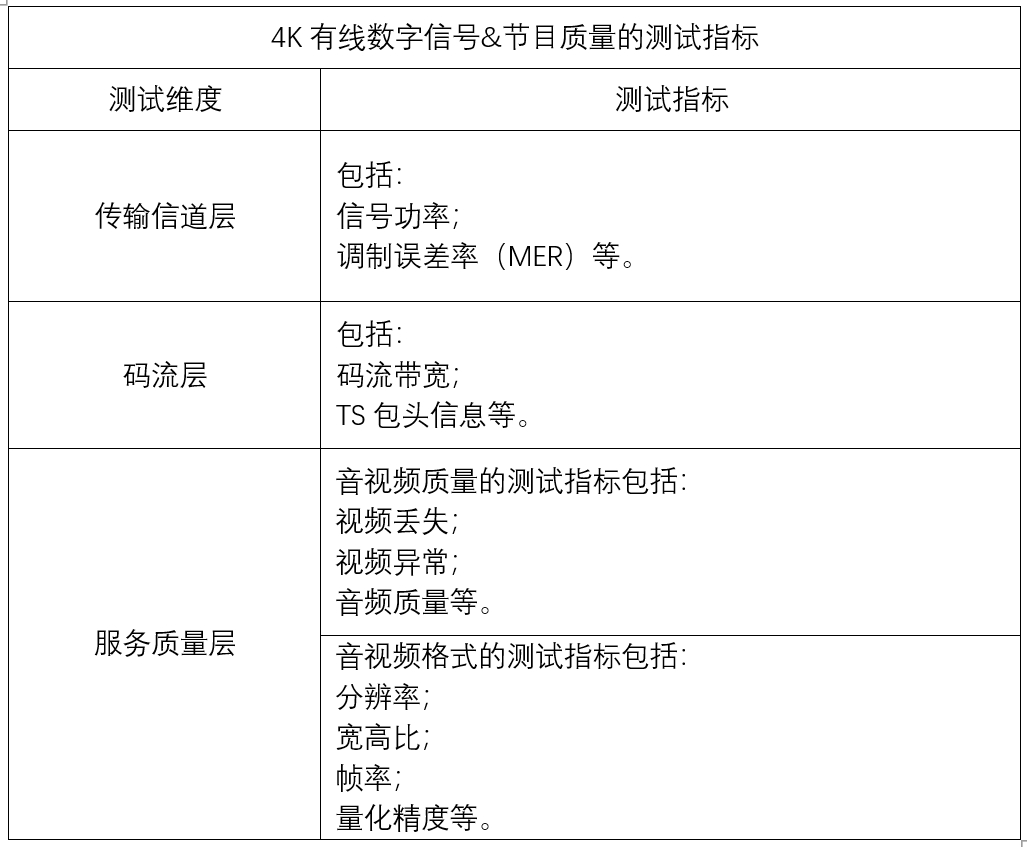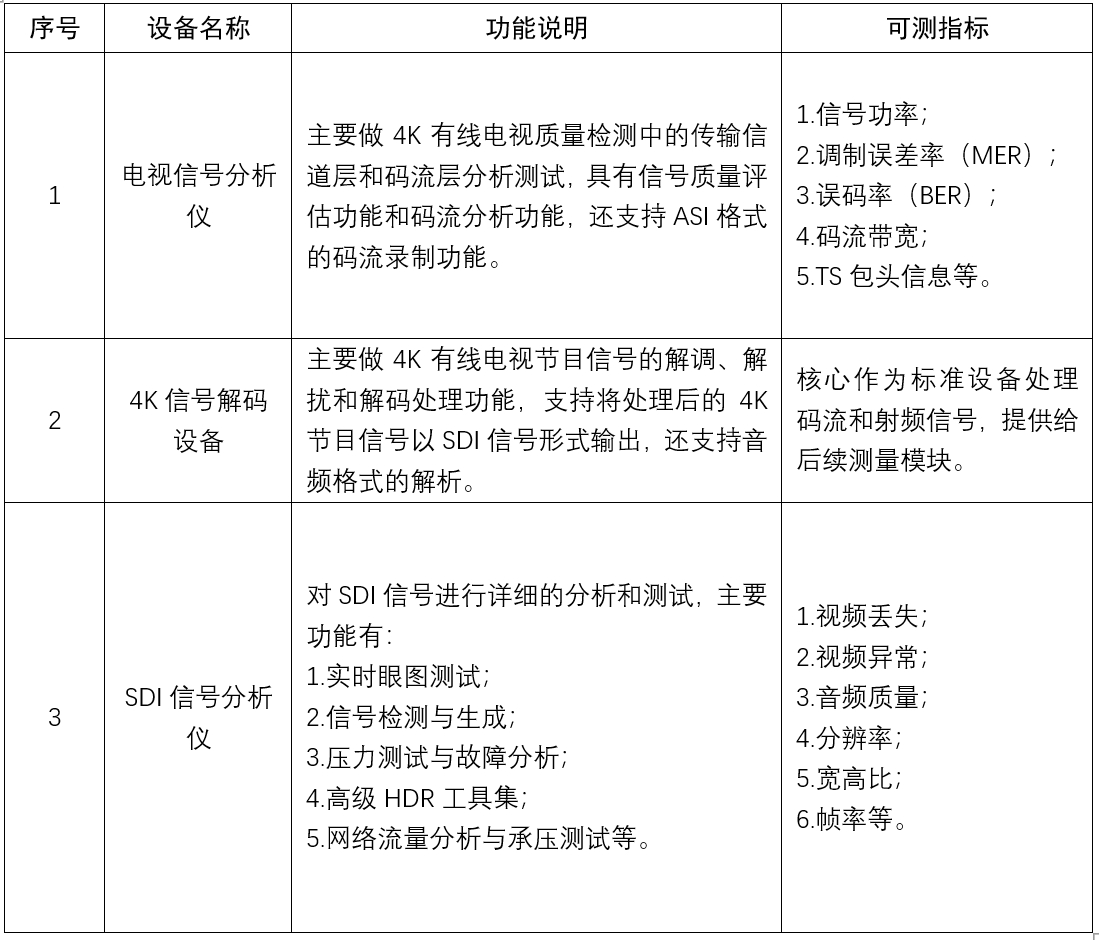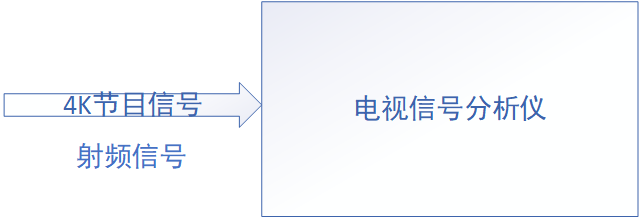1. Introduction
With the rapid development of technology, 4K Ultra HD television has become a significant component of modern home entertainment. To ensure audiences can enjoy high-quality 4K TV programs, conducting quality tests on 4K cable digital TV programs is particularly important. This document references the "Technical Quality Requirements and Measurement Methods for Cable Digital TV Audio and Video" released by the National Radio and Television Administration on August 18, 2023, which specifies the audio and video formats for 4K cable digital TV systems, as well as quality requirements and measurement methods for transmission channels, bitstreams, subjective assessment, etc. Building upon this foundation and incorporating practical measurements of 4K cable TV program quality, this document provides a specific and relatively comprehensive set of measurement methods.
2. Test Metrics
The processing of audio and video in a 4K cable digital TV system mainly involves key processes such as source encoding, bitstream multiplexing, and channel transmission. Therefore, for measuring the quality of 4K cable digital TV programs, we can adopt a layered testing approach, roughly divided into three layers: the transmission channel layer, the bitstream layer, and the service quality layer. For each layer, we list different test metrics, each with its corresponding threshold requirements, serving as evaluation criteria. Together, these test metrics provide a relatively comprehensive reflection of the current quality of the 4K TV program signal. Details are shown in the table below.

Table 1 Test Metrics for 4K Cable Digital Signal & Program Quality
1) Transmission Channel Layer Quality primarily refers to the quality of different cable digital TV transmission paths, such as QAM and IP, including the quality of cable digital channels and distribution networks.
2) Bitstream Layer Quality mainly includes bitstream quality, audio/video quality, and audio/video format. Bitstream quality is used to check the status of key indicators of the audio/video streams. Audio/video quality is used to check for potential anomalies in the program source and encoding/decoding/transcoding stages. Audio/video format is used to check the encoding formats of the audio and video.
3) Service Quality Layer primarily focuses on subjective audio/video evaluation, supplemented by objective audio/video quality assessment as a reference.
3. Test Methods and Block Diagrams
The key equipment used for testing, functional descriptions, and measurable indicators are shown in the table below.

Table 2 Equipment Names and Functional Descriptions Used
3.1 Transmission Channel Layer and Bitstream Layer Testing

The encrypted 4K program cable signal is output via an RF cable to the TV Signal Analyzer. Using the Signal Quality Assessment Function within the TV Signal Analyzer, the three metrics of the transmission channel layer are measured, yielding corresponding test results.
Subsequently, using the Bitstream Analysis Function within the TV Signal Analyzer, the three metrics of the bitstream layer are measured, yielding corresponding test results. The test results obtained from the TV Signal Analyzer are compared with the corresponding quality requirements. Based on the comparison results, a quality report for the bitstream layer test is generated.
3.2 Service Quality Layer Testing
We divide the service quality layer testing into two main parts: Audio/Video Quality Testing and Audio/Video Format Testing. The test block diagrams for each part are described below.
3.2.1 Audio/Video Quality Testing

Measurement Steps:
1、Connect the equipment according to the block diagram.
2、Control the 4K Signal Decoding Device via the PC, setting relevant parameters such as frequency, program number, and descrambling card. Ensure the decoder can correctly receive and decode the 4K cable digital TV signal.
3、Open the test interface of the SDI Signal Analyzer. Configure the analyzer to measure the required audio/video quality parameters.
4、After the 4K Signal Decoding Device demodulates, descrambles, and decodes the 4K digital TV signal, output it in SDI signal format to the SDI Signal Analyzer. Configure the SDI Signal Analyzer to play the audio/video content through connected speakers and a display.
5、Once video and audio content are playing, test personnel listen to the audio and watch the video, scoring the playback quality on a 1-5 point scale. Record the corresponding scores.
6、Generate an audio/video quality test report based on the measurement results.
3.2.2 Audio/Video Format Testing

Measurement Steps:
1、Connect the equipment according to the block diagram.
2、Control the 4K Signal Decoding Device via the PC, setting relevant parameters such as frequency, program number, and descrambling card. Ensure the decoder can correctly receive and decode the 4K cable digital TV signal.
3、Open the test interface of the SDI Signal Analyzer. Configure the analyzer to measure the required audio/video format parameters, such as resolution, frame rate, quantization precision, color gamut, and dynamic range.
4、Ensure the 4K Signal Decoding Device correctly receives the encrypted 4K cable digital TV signal. After the device demodulates, descrambles, and decodes the 4K program signal, output it in the final SDI signal format. The SDI Signal Analyzer then performs measurements on the received SDI signal to determine the audio/video format parameters.
5、Observe and record the measurement results on the SDI Signal Analyzer. Compare the measurement results with the corresponding quality requirements to determine if the audio/video formats comply with standards.
6、Generate an audio/video format test report based on the measurement results.
4. Conclusion
In the field of digital TV technology testing, we have accumulated extensive testing experience and are dedicated to providing high-quality services and solutions. For the testing needs of 4K cable digital TV programs, we offer professional and effective solutions. These solutions, combined with practical experience, aim to ensure the precision and reliability of the testing process. We sincerely invite you to contact us to discuss how we can bring an enhanced testing experience to your project. The journey ahead is long and arduous. We look forward to joining hands with you to create a new future in the field of digital television.
Beijing Doewe Technologies Co., Ltd. owns the independent brand "Doewe Instruments," focusing on the R&D, production, and sales of electronic test and measurement instruments/test systems. After years of development, the company's business scope covers multiple fields, establishing several business divisions: Broadcasting/AV Division, Transportation Division, University & Research Institute Division, and Consumer Electronics Division. We relentlessly pursue innovation in test and measurement technology, committed to technology development, application software services, and research into test and measurement solutions. To this end, we established the "Doewe Technologies Center" in Beijing and the "Qingdao Technology Service Center" in Qingdao. Relying on the Beijing headquarters and related technology centers, the company has gradually established a nationwide service and sales network, including Northeast China Office, East China Office, Southwest China Office, and South China Office, enabling us to provide timely pre-sales and after-sales service.
Tel: 010-64327909
Website: https://www.doewe.com
Email: info@doewe.com
Address: Room 1821, Building 2, Soubao Business Center, No. 16 Nan San Huan West Road, Fengtai District, Beijing